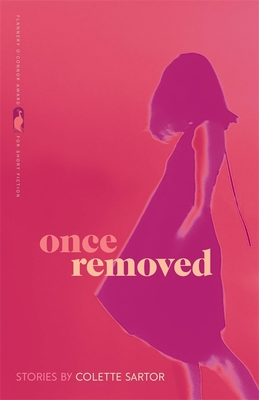Give us your elevator pitch: what’s your book about in
2-3 sentences?
The women in the linked short story collection Once Removed carry the burdens imposed
in the name of intimacy—the secrets kept, the lies told, the disputes initiated—as
well as the joy that can still manage to triumph. Some of these women possess
the fierce natures and long, vengeful memories of expert grudge holders. Others
avoid conflict at every turn, or so they tell themselves. For all of them,
grief lies at the core of love.
Which story did you most enjoy writing? Why? And, which
story gave you the most trouble, and why?
The story I most enjoyed writing was “Malocchio.” My work
usually includes bits and pieces of family lore, but this one contains the most.
“Malocchio” is about my favorite recurring character, Rose, who’s based on my
paternal grandmother. In it, Rose tells a story about starting kindergarten in
the 1940s from a reflective first person POV, an unusual narrative perspective for
me. I set the story in the city triplex where my great grandmother ran a dairy
farm and raised my grandmother and where my grandmother later ran a sweatshop
and raised my father and uncle. It was pure joy to imagine my brilliant,
vengeful, loyal grandmother as a child. In fact, I loved writing Rose so much
that she’s a main character in my novel-in-progress, Piecework, which is
based on a murder my grandmother helped cover up in the ‘70s.
The story that gave me the most trouble was “Jump.” “Jump”
involves estranged adult siblings, but the inspirational seed was a story my
mom used to tell about how she and her brothers made a game out of jumping off
the garage roof. I knew that scene would be more powerful told in the present
rather than as a flashback or in backstory. I also knew that writing that scene
in present day meant it would need to open the story, which in turn would
require a decades-long jump in time from that first scene to the next one. Given
how risky such a jump might be to pull off, I decided to really take some risks
and play around with structure, which somehow led me to intersperse the scenes
with text messages, which led to a draft so overly complicated that the story took
me years to complete.
Tell us a bit about the highs and lows of your book’s road
to publication.
Publication was an extremely long road for this collection.
I started writing short stories after I finished my MFA to give myself a break
from writing a novel that will forevermore live only on my hard drive. I knew I
needed to learn how to tell a better story, and short stories were faster to
finish and easier to analyze than novels. So I started writing my own short
stories and storymapped published ones, by which I mean I highlighted the
different structural elements of my favorite short stories (e.g., all the
dialogue in pink, all the present-day actions/gestures in blue, all the
expositional backstory in green, etc.) to figure out how the stories were put
together and why their structures worked.
Before I knew it, I was obsessed with short stories. That’s
all I worked on for years. The problem was, I wrote about whatever came to mind
without thinking about how my stories might fit together in a book. So when I started
trying to pull together a collection, I realized that my stories weren’t
sufficiently linked to feel compelling as a whole. Instead of finding a way to
make them more cohesive, I just put my strongest stories first and last, buried
the weaker ones in the middle, slapped on a title, and submitted the “collection”
to contests. That approach resulted in a few nibbles but mostly generic
rejections.
It wasn’t until a few years ago that I forced myself to do
the hard work of figuring out the connective tissue between my stories—not just
themes, but also characters, settings, histories, timelines. I kept refining
those connections, finished a few more stories, and worked with editor Matthew
Limpede to ensure the collection felt whole. Then I forced myself to submit it to
the Flannery O’Connor Award contest—one of the ones that had nibbled but
rejected my previous efforts. A few months later, I got a text/ phone call from
Lee K. Abbott to say my collection had won.
What’s your favorite piece of writing advice?
Show don’t tell is bullshit.
My favorite writing advice is “write until something
surprises you.” What surprised you in the writing of this book?
That I finished it. I’m only partially joking. I almost
abandoned this book many, many times. I’m forever grateful to Matthew Limpede
for encouraging me to finish it and to Lee K. Abbott for choosing it for
publication.
How did you find the title of your book?
The title came from one of the collection’s stories, about a
woman trying to find her place—if any—in her new boyfriend’s fractured family. That
story and its title best embodied all my characters’ struggles to shoulder the
responsibilities of family and intimacy without abandoning their own identities
and desires.
Inquiring foodies and hungry book clubs want to know: Any
food/s associated with your book? (Any recipes I might share?)
Italian food, most definitely. Your question inspired this post
about my obsession with food, which includes my mom’s sauce recipe: https://colettesartor.com/once-removed-my-food-obsession/
****
READ MORE ABOUT THIS AUTHOR: https://colettesartor.com
READ MORE ABOUT THIS PUBLISHER: https://ugapress.org/
ORDER THIS BOOK FOR YOUR TBR STACK: https://www.indiebound.org/book/9780820355696
READ A SHORT STORY, “Bandit” (in a slightly different
form): http://www.reduxlitjournal.com/2014/12/150-bandit-by-colette-sartor.html
